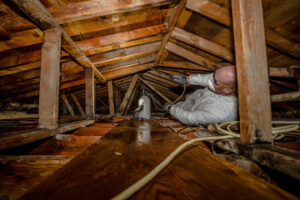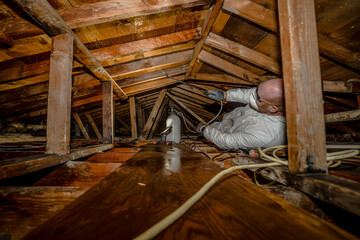Asbestos is found in various building construction materials, including shingles, flooring, ceiling tiles, asbestos cement products, and friction products (automobile clutch and brake faces). It can also be found in paints, rugs, paper, plastics, and fabrics.
 Only an experienced professional at Asbestos Testing Colorado Springs should take asbestos samples. Improper sampling can cause the release of dangerous fibers into the air.
Only an experienced professional at Asbestos Testing Colorado Springs should take asbestos samples. Improper sampling can cause the release of dangerous fibers into the air.
Costs
A contractor who performs asbestos testing will charge for both labor and the price of the inspection and test samples. Labor costs will depend on the size of the property and the type of test required. The larger the house and the more types of materials to test, the greater the expense. Similarly, tests performed on harder to reach areas will be more expensive than those done in easier to access spaces.
Before the ban in the United States, builders used asbestos as a common material for insulation and other household construction. Asbestos is very durable and provides good insulation, but it crumbles and flakes easily when damaged, releasing harmful carcinogenic fibers into the air. These fibers can then be inhaled by homeowners or workers performing renovations and other work on the home. Asbestos can be found in floor tiles, roof tiles, ceiling shingles, pipe insulation, wallboard, fire protection panels, and heating pipe insulation.
An inspector will typically use a number of different types of tests to locate the presence of asbestos on a property. The most common is an air test, which will take a sample of the air to see whether any asbestos fibers are present. A professional may also use a water test to determine whether any asbestos particles are present in your house’s plumbing system.
Depending on the type of inspection you require, the professional will also need to collect and analyze various other types of test samples. These could include a few scrapings of vinyl flooring, popcorn ceilings, and other hard-to-reach materials to identify the presence of asbestos. Samples of thermal or blown-in insulation, acoustic ceiling tiles, and piping will also need to be tested.
Once the results of the test come back, the inspector will need to decide on the best course of action for your property. If the asbestos material is not damaged or deteriorating and will not be disturbed, it may not need to be removed. However, if the material is in poor condition or is going to be disturbed in some way, it will need to be repaired and sealed or encapsulated.
Sampling Procedures
For samples to be useful in determining the presence of asbestos, they need to be collected and analyzed in a specific manner. This is why it is important to hire an inspector who has extensive knowledge and experience in collecting and analyzing asbestos samples. This includes understanding how the sampling process works, and the limitations of each sample type and collection method.
A good inspector will perform a visual examination of the suspected asbestos-containing material, and will carefully collect and analyze samples to determine the presence or absence of asbestos. In addition, the inspector should be able to recommend corrective measures and provide a detailed report of his/her evaluation.
In order to collect an accurate sample, it is best to keep the number of persons involved in the sample process to a minimum. This will help to reduce the chance of contaminating the area from which the sample is taken, as well as prevent any accidental spills of the sample material. To minimize the possibility of contamination, a person taking an asbestos sample should wear disposable gloves and wash their hands before and after taking the sample. It is also a good idea to cover any furniture and carpeting, and shut down any heating or cooling systems in the area where the sample is being taken.
When sampling a suspect asbestos-containing material, it is advisable to use a small knife or corer to cut a small piece of the material and place it in a clean container such as a 35 mm film canister, glass or plastic vial, or high quality resealable bag. It is important not to disturb the sampled material, as this can release fibers which may be inhaled and cause illness. Wetting the sampled material with a fine mist of water that contains a few drops of detergent before cutting it can help to reduce the release of fibers.
If the material is being analyzed for asbestos, the appropriate type of microscopy should be used. Polarized light microscopy (PLM) is the most common technique for testing building materials and soils for asbestos, but samples can also be analyzed using electron microscopes (TEM). The TEM technique is used to identify and count individual fibers.
Sample Collection
While it is possible for homeowners to collect asbestos samples themselves, it’s important to understand that there are risks associated with doing so. Asbestos can cause serious health problems, so it’s best to leave the job to a qualified professional. A professional will be able to identify areas where asbestos is present and extract it safely, reducing the chance of further contamination.
It’s essential to isolate the area and make sure no other people are in the vicinity during the sample collection process. The person taking the sample should wear protective equipment including a respirator and disposable overalls. They should also use a drop sheet to prevent any asbestos dust from spreading around the area. It’s also a good idea to shut down any heating or cooling systems and turn off fans during the sampling process.
The next step is to remove a small section of the suspect material using a razor blade, coring tool or sharp knife. The piece should be cut as close to the entire surface of the material as possible. Then, it should be placed into a clean container. This could be a 35 mm film canister, small glass or plastic vial or a high-quality resealable plastic bag. It’s important to label the container with an identification number and clearly state when and where the sample was taken. It’s also a good idea
to patch the area where the sample was taken with the smallest piece of duct tape possible to reduce the risk of fibre release and to ensure that the sample isn’t disturbed further. The area should then be covered with a drop sheet and the sample container sealed. Finally, the samples should be disposed of in accordance with local and state regulations.
Asbestos can be found in a wide range of construction materials. Some of the most common are chrysotile, amosite and crocidolite. This mineral was used to strengthen products and provide heat insulation and fire resistance. In addition to building materials, asbestos has been used in automobile brakes, clutch facings, paper and paints. While naturally occurring asbestos isn’t a health hazard, if it is disturbed during construction or renovations, it may become airborne and pose a threat to people in the vicinity.
Analysis
Asbestos analysis is done using polarized light microscopy (PLM), transmission electron microscopy (TEM), and other techniques. Those conducting the analysis must have taken the NIOSH course in sampling and analysis of airborne asbestos. Each laboratory engaged in asbestos analysis must set up a slide trading arrangement with two or more other laboratories to exchange slides on a regular basis. This helps to eliminate inbreeding and to ensure that each laboratory is getting consistent, accurate results.
Undisturbed asbestos materials in good condition do not pose a health risk. Only when these materials are disturbed and their microscopic fibers become airborne do the potential risks arise. These fibers are ingested or inhaled into the respiratory tract and can cause lung cancer, other respiratory diseases, and other health issues.
Once inhaled, these fibers can also enter the body’s other organs and tissues. When asbestos fibers reach the lungs, they can become lodged in small air passages and irritate them. This can cause inflammation and scarring, which can lead to chronic coughing or difficulty breathing. Inhalation can also lead to pleural plaques, which are a gelatinous material that forms in the lining of the lungs.
Although most asbestos is no longer used in manufacturing building materials, many products that were manufactured before the 1980s still contain asbestos. These products include floor tiles, ceiling tiles, shingles, insulations, acoustical plaster sprays, insulating cements, and automotive brakes. These products can release asbestos fibers into the air when they are disturbed during repair, maintenance, or demolition activities.
If you suspect that your property contains asbestos, it’s important to hire a NJ-state certified testing service. These professionals have the proper training to identify residential asbestos safely, and they understand the best guidelines for safe home renovations. They will take samples of suspect building materials and send them to a lab for asbestos testing. They will then prepare a report on the location and extent of the ACMs. This report should be clear and unambiguous. It should also include a recommendation for correction or prevention. The inspection and sampling process should be repeated as necessary.
